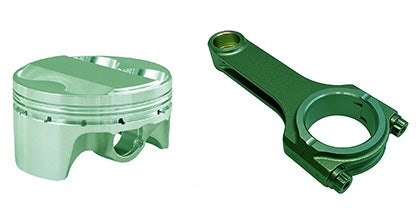Precision's 6870 Next Gen VS Gen 2 Turbocharger | 2JZ Engine Dyno Testing
Purpose:
Precision Turbo’s 6870 Turbocharger Family has been widely used by the aftermarket and racing community since its release late in 2014 as a second generation (a.k.a. “Gen 2” or “G2”) product line. New for February 2024, the long-anticipated update for the 6870 to Precision’s Next Generation (a.k.a. “Next Gen” or “NG”) compressor wheel technology.
We aim to accurately conduct repeatable tests on both turbochargers while striving for operation under similar circumstances. Furthermore we aim to present the community with easy-to-understand and informative education in order to make informed decisions for their needs.
To do this, we need to first present the conditions at which the tests were conducted:
Intentional Starting Variables:
Test 1: 6870HP Gen 2
Test 2: 6870HP Next Gen
Constants & Conditions:
Engine: 3.2L 2JZ-GTE w/ 10.0:1 C/R w/ Ported GTE Cylinder Head (Click Here)
Fuel: One Ethanol 117R
Turbine Housing: 1.00 A/R Divided T4
Dyno: Superflow SF-Powermark
Boost Controller Target: 40.0psi
Engine Acceleration Rate: 600 rpm/sec
Start & End RPM: 4,600rpm - 8,100rpm
Engine Coolant Temperature: [Test 1/Gen2: 158.0* F; Test 2/Next Gen: 159.0*F]
Ambient Air Temperature: [T1/G2: 71.3* F; T2/NG: 69.0* F]
Humidity: [T1/G2: 69.5%; T2/NG: 71.6%]
Unintentional Starting Variables w/ >10.00% Deviation:
Density Altitude: [T1/G2: 815ft; T2/NG: 573ft]


Test Notes:
We utilize a SuperFlow SF-Powermark Engine Dynamometer for our testing. This is a high-capacity water brake dyno that precisely controls load and speed of the engine using SuperFlow’s automated closed-loop systems to test high-output engines up to 15,000 RPM and over 2,500 HP.
For these tests, the engine boost target was set to 40 PSI and the engine acceleration rate was set to 600 rpm/sec.
The way an engine dyno operates and the data that we’re able to achieve is not always directly comparable to a chassis dyno. On a chassis dyno, the vehicle’s various components are still in play - torque converter, traction, etc. On an engine dyno, since we can load the engine at any RPM we want (even at idle), you cannot directly compare the early powerband of an engine dyno to a chassis dyno due to the elimination of those variables that affect spooling characteristics.
The entire turbo system outside of the 6870 Supercores remained the same between the two tests. Both tests were performed through an Artec divided T4, twin-gate, exhaust manifold and our custom Plazmaman air-to-air intercooler.
Results:
The Gen 2 and Next Gen 6870 share the same turbine wheel so where does the additional power come from? The main difference between these turbochargers can be found in their compressor wheels and matching compressor covers. Precision advertises that their Next Gen wheel design flows 10% more air over its Gen 2 model, and has an extended compressor exducer tip to help “scoop” additional air. More air = More power!


It's important to note that both of these turbochargers have a higher maximum horsepower rating than where we tested them. Horsepower is a function of torque at RPM. To find horsepower, you can take torque multiplied by the RPM it occurred at, divide by the constant of 5,252, and the resulting number is horsepower.
lb/ft TQ * ____rpm / 5,252rpm = HP
Conversely:
HP * 5,252rpm / ____rpm = lb/ft TQ
The higher the RPM where an engine is operating, the more horsepower a given torque force yields.
For example, if you were to take a 400lb/ft Small Block V8 that may make this torque at 3,000rpm, the resulting horsepower would be 228.48hp. The same 400lb/ft at 6,000rpm is 456.97hp. The same 400lb/ft at 9,000rpm is 685.45hp.
Meaning that while these turbochargers had a peak torque of around 816lb/ft @ 6,400rpm on our 3.2L 2JZ example (resulting in 994hp), a larger engine would be able to achieve its peak torque earlier (resulting in a lower peak “power”) and a smaller engine may not be able to achieve this peak torque until later, which would result in a higher peak power. In our test, peak power was achieved at 7,600rpm, when torque had already fallen to 743lb/ft, almost 10% down from the peak 1,200rpm earlier. As such, it is important to understand where your particular engine will operate, and make your decisions based on that use case.


Peak Power:
6870 Gen 2: 1,043hp at 7,000rpm
6870 Next Gen: 1,074hp at 7,600rpm
8,100rpm Power:
6870 Gen 2: 1,002hp
6870 Next Gen: 1,067hp
Interpreting these results & what they mean for you:
At the 40psi target, the Next Gen made 31.6 more peak horsepower over the Gen 2 model, and 65.9 more horsepower at the 8,100rpm end of this test. The Gen 2 6870 continues to offer outstanding value and performance as it has for almost a decade, but the Next Gen in our initial testing seems to be all positives with no negatives. The compressor was still performing admirably well at 8,100rpm and could have likely carried acceptable power even further on this test application, as it had only just begun to fall away from the boost target, where the Gen 2 unit was clearly running out of flow.
Both are available in the smaller SCP (4.00” Inlet / 2.50” Outlet) housing as well as the HP (4.00” In / 3.00” Out) housings we tested it with, and these compressor wheels are available with the 75mm turbine for larger displacement applications. How would this information translate to your race program? When selecting a turbocharger for your build, it’s important to think about where in the RPM range you’ll be spending most of your time, and how hard you’ll be running. In most racing scenarios, you’ll likely be spending the most of your time in a high RPM environment.


Taking a closer look at our data, you can see that both units behaved very similarly from 4,600rpm up through roughly 6,700rpm. The two units achieved nearly identical peak torque (+/- <0.3%) and until 6,700rpm, both turbochargers tracked close to one another in power output. The Next Gen’s compressor wheel does a substantially better job carrying the power and torque after this peak over the last 20% of the test, even faced with slightly increased exhaust pressures.


6870 G2 Avg. Exhaust Back Pressure & Boost: 53.6psi EBP vs. 36.6psi Boost
6870 G2 Max. EBP: 55.4psi
6870 G2 Min. Boost: 34.3psi
6870 NG Avg. Exhaust Back Pressure & Boost: 55.5psi EBP vs. 38.2psi Boost
6870 NG Max. EBP: 61.9psi
6870 NG Min. Boost: 37.6psi
What does this information mean for you? Precision affords us the ability to select compressor and turbine options largely independently. If you have an engine of similar size and power, you can look at these exhaust pressure numbers to understand what your engine is dealing with at this power level through this turbine, and you can use that to size your compressor wheel, exhaust housing, and various other choices. If you’re an existing 6870 G2 customer and you’re looking for more performance out of an otherwise-identical package, Precision brings to us an opportunity that seems like it only wins at this point, with a substantial and noteworthy compressor upgrade to this Next Gen platform.
If you have any other questions or are ready to purchase, give one of our build advisors a call. We will help you maximize the enjoyment of your next project by helping you make educated choices each step of the way.











